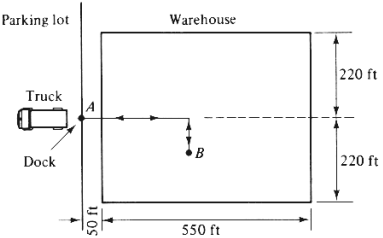1 . The time spent on loading the forklift (at the truck
location, A) is approxi-
mately constant and equal to 15 seconds.
2. All cargo from each intercity truck is transferred to the
same designated storage
location (B) in the warehouse.

3. For a given truck, any storage location in the warehouse is
equally likely.
4. The average unloading time at B, including turning and
reversing, is 10 seconds
(negligible variance).
5. The forklift travels at a constant speed of 5 feet per
second, and, because of the
warehouse layout, in the east-west and north-south directions
only.
6. Exactly 10 forklift loads are required to empty each truck.
7. Trucks are served one at a time and leave the dock as soon
as they are emptied; the
docking/undocking times for each truck last considerably less than
a roundtrip by a
forklift, so that no forklift time is wasted because of truck
maneuvers.
In the following we shall refer to the truck parking lot and the
dock as "the
system."
a. Given that one truck arrives at the system every 50 minutes
on the average and that
the arrivals follow a Poisson process, find the average number of
trucks in the system at
any given time and the average time each truck remains in the
system.
b. If two forklifts are used instead of one, answer
approximately the questions in part
(a) with an appropriately defined M/G/1 model. Assume that the
forklifts do not interfere
with one another throughout the operation.
Hint: What happens to the mean and variance of the service
time?
c. Use approximate bounds for M/G/2 systems (Section 5.8) to
answer the questions in
part (b) and compare these answers with your answers in (b).